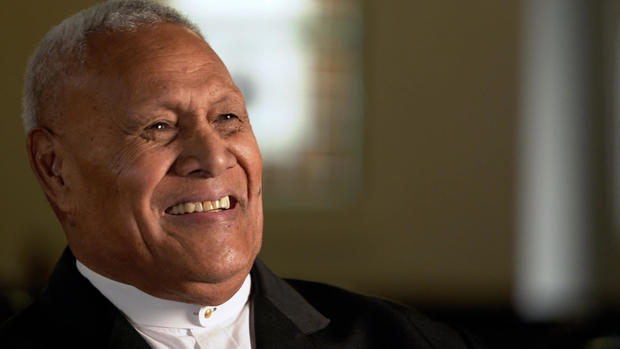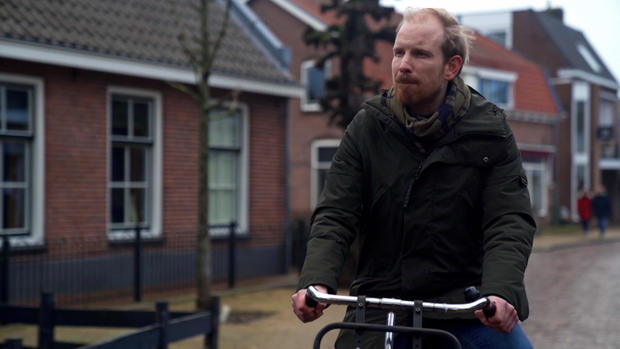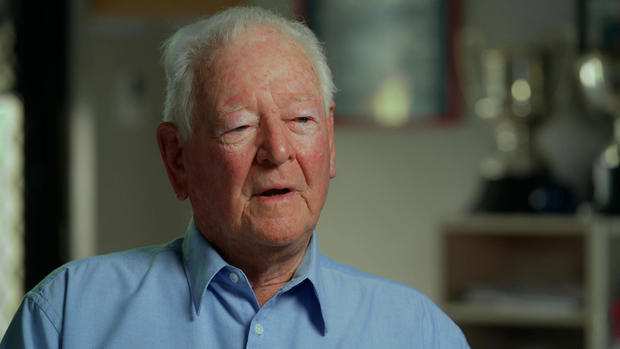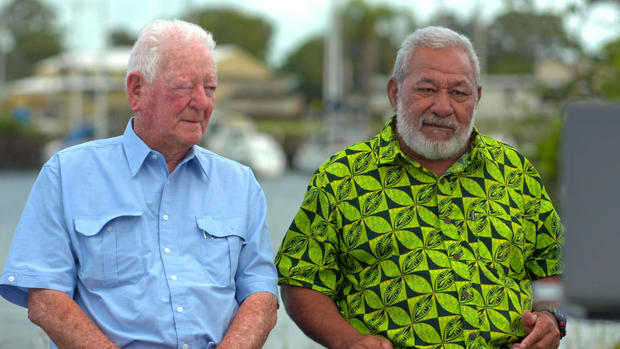Tonight, we have a history of solidarity, hope and, finally, survival in the face of adversity. It happened over 50 years ago, but when it was rediscovered last year it caused a sensation. It is the story of a group of school boys stranded on a remote and deserted island for more than 15 months. This may remind you of the famous novel – Lord of the Flies, by William Golding – but, as you will see, the outcome of this real-life story could not have been more different.
The story begins in 1965. Mano Totau and five of his friends studied at a boarding school in Tonga, an island nation in the Pacific Ocean. Bored, rebellious and eager for adventure – they stole a traditional whaling boat – and with reckless abandon they left for Fiji.
Holly Williams: Did he have an engine?
Mano Totau: No, without an engine.
Holly Williams: But Mano, isn’t Fiji about 500 miles from Tonga?
Mano Totau: A little less.
Holly Williams: Did you have a map or a compass?
Mano Totau: No. (LAUGHTER)
The teenagers may have been raised at sea, but they soon realized that they had made a terrible mistake. On the first night, a violent storm tore the sails off the mast and tore the rudder off the boat.
For more than a week, his damaged boat drifted aimlessly. Sione Fataua, 17, the oldest in the group, told us that they were convinced that they would die.
Sione Fataua: No food, no water. We were just wandering in the wind. And after eight days we saw the island.
It was a volcanic island that protruded from the sea. As the boat approached, a wave hit it on the rocky shore, leaving it in pieces. The exhausted teenagers struggled to get to the beach.
Mano Totau: The only thing we do is to hold on and pray, “thank you, my God”.
Later, the students discovered that they had drifted hundreds of miles from where they had left and landed on the island of ‘Ata – on maps, nothing more than an uninhabited spot.
It was such a remarkable story that later an Australian television crew brought the teenagers back to ‘Ata to re-enact their experience. In the film, Sione, Mano and their friends show how they survived.
Film “The Castaways”: They managed to rescue a paddle and a piece of wire and, with that, they set out to get what they hoped would be their first meal in 8 days.
They demonstrate how they ate the fish they caught raw and quenched their thirst by attacking seabird nests – drinking their blood and raw eggs.
Holly Williams: Any food, anything to drink.
Mano Totau: Any food. No matter how horrible and dirty it is, it is a very beautiful thing to have back then.
When they recovered their strength, Mano and Sione told us, they climbed the wooded plateau of the island where they found a clay pot, a machete and chickens, all left behind by a small Tongan community that lived in ‘Ata before they were uprooted from your home by slave traders a century earlier.
But they told us that everything changed when they finally made a fire – and started preparing hot meals.
Holly Williams: How did you prevent this from happening?
Sione Fataua: I tell the guys, everyone has a duty to fire. You have to take care of the fire and pray for that night, and to get up in the morning, it is still lit.
The fugitive teenagers showed remarkable resourcefulness – building a hut with palm leaves, establishing a garden with bananas and beans and establishing a stopover to watch the passing ships. They even built a badminton court and an improvised gym. They lived in harmony – we were told – most of the time.
Holly Williams: But, come on, Mano. You were teenagers. You must have argued.
Mano Totau: Yes, and we disagree.
They calmed down by walking to opposite sides of the island, says Mano, although sometimes things got out of hand.
Holly Williams: So, if there was a fight, how did you stop it?
Mano Totau: You slap him or something, and tell him, “shut up and be quiet, sit down, listen”.
Holly Williams: There must have been times when you were depressed, when you thought you would never see your family again.
Sione Fataua: It was difficult. And I was – pray to God and – and I promise him, “if you can bring me back, I will serve you for the rest of my life”
For more than 50 years, the real life story of Sione, Mano and their friends was little known outside of Tonga … until Dutch historian and bestselling author Rutger Bregman found him on the internet. He flew around the world to meet Mano and made history the cornerstone of his new book, Humankind: A Hopeful History.
Rutger Bregman: And I just couldn’t understand how it didn’t become, you know, one of the most famous stories of the 20th century. I just couldn’t understand it, because it’s just extraordinary, six kids on an island for 15 months. And how did they survive?
Like millions of others, Bregman read the fictitious tale of abandoned students, Lord of the Flies, which for generations has been taught in high schools around the world.
The novel – later made into a film – is a nightmare story of a group of British boys trapped on an uninhabited island. They split into two competing tribes and fall into violence – culminating in confusion and murder.
Rutger Bregman: This is a very old theory in Western culture, that our civilization is just a thin varnish, just a thin layer. And that when something bad happens – say there is a natural disaster or you are shipwrecked on an island and you are free to establish your own society – people will reveal who they really are. You know, the people at the bottom are just selfish.
Holly Williams: And are you saying that the basic idea behind the novel, Lord of the Flies, is wrong? Are you saying it would never happen?
Rutger Bregman: Well, if tens of millions of children around the world still need to read Lord of the Flies at school today, I think they also deserve to know about this one moment in world history when real children were shipwrecked on a real island, because this is a very different story.
A history of cooperation, hope and eventually salvation. In September 1966, after 15 long months, Australian lobster fisherman Peter Warner was sailing close to ‘Ata when he spotted a burnt area. When he approached, he was shocked to see a human figure.
Peter Warner: And that first figure was swimming towards us doing the Australian tracking, as I call it. And then five other bodies jumped off the cliff and into the water and followed.
They boarded and told the crew how they fled the boarding school and ended up shipwrecked. Peter radioed Nuku’alofa, the capital of Tonga, to check their history.
Peter Warner: And the operator said in tears, “It’s true. These boys were students at this college. They were said to be dead. Funerals were held. And now you’ve found them.” So, it was a very exciting time for all of us.
Holly Williams: So you knew you were going home.
Mano Totau: Yes
Holly Williams: How did you feel?
Mano Totau: It’s like entering the door of heaven.
But heaven would have to wait – when they returned to port, they were immediately arrested.
Holly Williams: So Peter Warner rescued you and took you back to Nuku’alofa, where everyone thought you were dead. And then you were arrested?
Sione Fataua: Yes. We are arrested because we stole the boat. (LAUGHTER)
Peter Warner told us that he paid the owner of the stolen boat – and finally took the fleeing students back to their home island, accompanied by the Australian television crew that had flown to film their story. They captured the teenagers’ reunion with their families.
Movie “The Castaways”: Our boys are back …
Sione Fataua: My mother, she was swimming before I left the boat. I am the first to go to the beach and give me a hug.
Film “The Castaways”: There has never been so much joy …
Peter Warner: The entire population of this small island was on the beach, hugging the boys. The parents cried. Then the party started. Six feast days.
History has never been forgotten on these islands, but when a British newspaper published a chapter of Rutger Bregman’s book last May, the story of Tongan teenagers went viral – 7 million people read it in a few days. Hollywood studios went into a bidding war for the film’s rights.
Holly Williams: Why were so many people around the world surprised and captivated by you telling the story?
Rutger Bregman: Maybe we need to hear it? Perhaps especially now, in the middle of a pandemic? It’s just that people were looking for a story that would give them hope about a different way of living, that a different society is possible. That it is not just violence, selfishness and greed within human nature, but that we can build something different. Maybe it’s because of that.
It has been 55 years since the wrecked students were rescued. They never had any doubts about how or why they survived.
Sione Fataua: I think it is the culture where we came from. We’re close. Really close family. We share everything. We are poor, but we love each other.
The teenagers had no interest in returning to the classroom, at first they worked for Peter Warner, who set up a fishing company in Tonga. Sione, as promised, later became a minister – he is now the head of the Church in Tonga in America. Mano graduated as a chef and moved to Australia. For half a century, he and Peter Warner have been best friends – whenever they can, they go sailing – forever pulled back to the Pacific Ocean, where their friendship began.
Holly Williams: Why do you get along so well, you know, all these years after the rescue?
Mano Totau: I think we feel strongly that we have something to help each other.
Peter Warner: Yes, and also –
Mano Totau: Teaching each other.
Peter Warner: And also, we have common beliefs that helped you overcome that ordeal on the island, you know, love, compassion and …
Mano Totau: Yes.
Peter Warner: Justice, unity.
Mano Totau: We both believe in the same thing.
The teenagers composed a song when they were on the island of ‘Ata – Siosionoa – seeing nothing every day. This takes Mano back to a time when they were homesick, and before they could imagine that their history can have lessons for all of us.
Produced by Michael H. Gavshon. Associate producer, Nadim Roberts. Transmission associate, Annabelle Hanflig. Edited by Daniel J. Glucksman.





